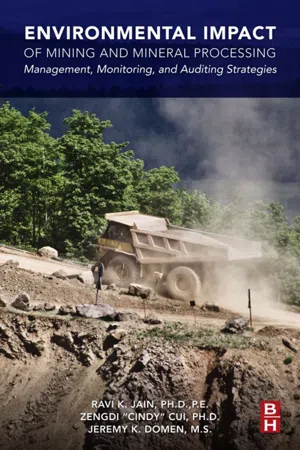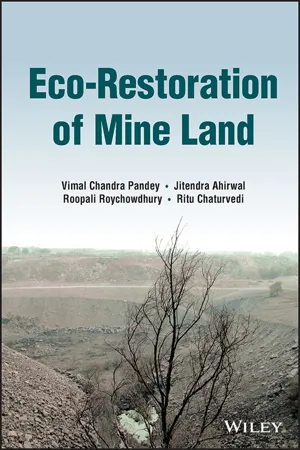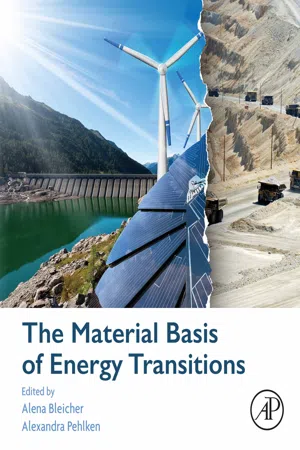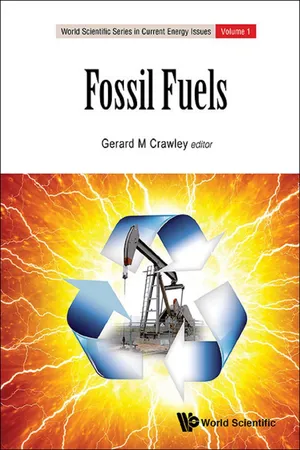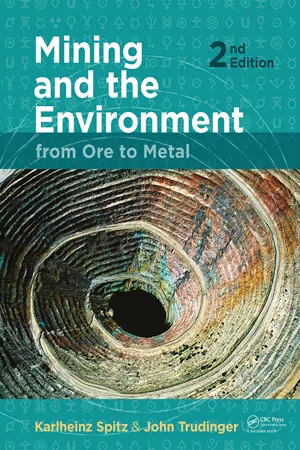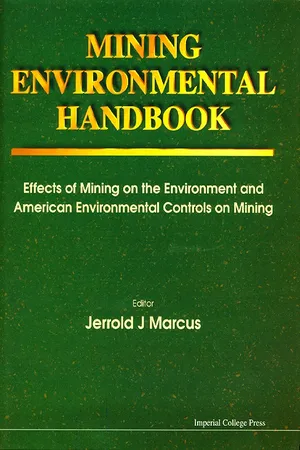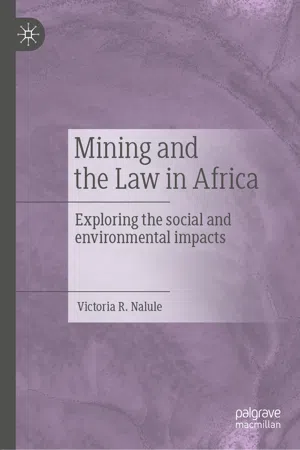Geography
Environmental Impact of Mining
The environmental impact of mining refers to the negative effects on the surrounding ecosystem caused by mining activities. These impacts can include habitat destruction, soil and water contamination, and air pollution. Mining can also lead to deforestation, loss of biodiversity, and disruption of local communities. Efforts to mitigate these impacts include reclamation and restoration of mined areas, as well as implementing sustainable mining practices.
Written by Perlego with AI-assistance
Related key terms
1 of 5
12 Key excerpts on "Environmental Impact of Mining"
- Vierah Hulley(Author)
- 2019(Publication Date)
- Delve Publishing(Publisher)
IMPACT OF MINING AND MINERAL PROCESSING CHAPTER 7 CONTENTS 7.1. Introduction .................................................................................... 172 7.2. Geological Effects of Mining on The Environment ........................... 174 7.3. Impact of Mining And Mobile Sources ............................................ 180 7.4. Impacts of Mining Projects on Wildlife ........................................... 182 7.5. Key Environmental Impacts Due To Mining ..................................... 185 7.6. Social Impact Identified In Various Divisions Across The World .......................................................... 191 7.7. Impact Of Mining On The Organic Environment ............................. 195 7.8. Case Study: Facilitating Responsible Mineral And Energy Dev elopment .................................................................... 196 References ............................................................................................. 201 Mineral Resources and Sustainability Assessment 172 There are many impacts of mining and mineral resources on the different part of our biodiversity. It is very important to understand that mining, once the most beneficial aspect for the societal development, has now become the main reason for the degradation of the. The impacts of mining should be considered in a manner that incorporates sustainable develop-ment (SD). 7.1. INTRODUCTION The process of mining refers to the extraction of mineral sand some other geological resources that are of economic value, from the deposits that are inside the earth. As a matter of fact, the process of mining has the full probability of causing some severe and negative effects on the environment. The adverse effects that have been majorly reported are the loss of biodiversity, erosion of soil, severe contamination of the surface water, contamination of groundwater, and soil.- eBook - ePub
Environmental Impact of Mining and Mineral Processing
Management, Monitoring, and Auditing Strategies
- Ravi Jain(Author)
- 2015(Publication Date)
- Butterworth-Heinemann(Publisher)
(Table 4.37) . Separating ecological impacts from air, water, and land impacts is often difficult as all three often result in significant ecological impacts as well. Specific details on ecological impacts related to reductions in air, water, and land quality from mining and mineral processing can be found in previous sections. Habitat loss, fragmentation, and pollution from mining activities have the most profound impact on local and regional ecology.Table 4.37 Mining activities that can negatively impacts habitats, biodiversity, and regional flora and faunaMine activity Environmental effect Examples of biodiversity impact Extraction Land clearing Loss of habitat, introduction of plant disease, siltation of watercourses Blasting Dust, noise, vibration Smothering stomata, disturbance of fauna Digging and hauling Dust, noise, vibration, water pollution Disruption of watercourses, impacts on aquatic ecosystems due to changes in hydrology and water quality Waste dumping Land clearing, water and soil pollution Loss of habitat, soil and water contamination sedimentation, acid mine drainage Processing/Chemical use Toxicity Loss of species (fish kills, for example) or reproductive impacts Tailings management Land clearing, water pollution Loss of habitat, toxicity, sedimentation, water quality and stream flow Air emissions Air pollution Loss of habitat or species Effluent discharges Water pollution Loss of habitat or species, reduced water quality Building workshops and other structures Land clearing, soil and water pollution Loss of habitat, contamination from fuel, waste disposal - eBook - PDF
- Vimal Chandra Pandey, Jitendra Ahirwal, Roopali Roychowdhury, Ritu Chaturvedi(Authors)
- 2022(Publication Date)
- Wiley(Publisher)
And hence, mining closure plan must be designed scientifically justifying actions and measures adopted to prevent pollution and the insurance of funds for reclamation. 1.2 Environmental Impacts of Mine Land and Ecological Disruption Minerals obtained from mine lands are limited and nonrenewable in nature. Due to their applications in various industries, reckless exploitation of these natural resources often leads to environmental imbalances. Mining activities are known 1.2 Environmental Impacts oo Mine Land and Ecolooical isrdption 5 to impact forest ecology, wildlife, local climate, and water balance of the area. The Sustainable Development Networking Programme, India states how mining activities in a region affect natural resources in an area (Table 1.1). Figure 1.1 illustrates the pathway of receptivity of pollutants from mine sites to plants, animals, and humans. Mining activities amend the landscape completely to a hostile state and are responsible for multiplex environmental issues. The magnitude of ecological impacts is not just limited to aesthetics and visual features but extend from soil erosion to pollution of air and water, habitat destruction to loss of species, result- ing in overall perturbance to environment. These disruptions reduce the range of biological activities in proximity of mine site leading to decline in function and stability of the ecosystem (Li et al. 2016). Mining activities not only lead to pollution but also modify the landscape significantly, and hence disrupting the micro- climate of that region. 1.2.1 Soil Erosion Clearing vegetation and excavations are the first phases of any mining project. Open-pit sites, overburden heaps, tailing piles, dump leaches, etc. contribute chemical pollutants and are prime sources of sediment loading. The eroded sedi- ment as a part of surface runoff often gets deposited in nearby floodplains or loads into surrounding water bodies. - eBook - ePub
- U. Aswathanarayana(Author)
- 2003(Publication Date)
- CRC Press(Publisher)
CHAPTER 5 Impact of mining on the environment – waste-wise5.1 INTRODUCTION
Almost all the mining involves the penetration of the lithosphere through quarries, opencast mines and the underground mines. Hydrosphere comes into the picture in the process of working the river placers and extracting minerals (usually heavy minerals, but in the case of Namibia, diamonds) from the seabed. Mining and extraction of minerals have impacts on rocks, soils, water, air and the biota.Three types of changes may be expected as a consequence of mining: (1) Change in the natural topography, and the consequent disturbance in the suitability of land for various uses, such as, agriculture and forestry, (2) Change in the hydrogeological condition, affecting groundwater and surface water, and (3) Change in the geotechnical conditions resulting in the deformation of the natural conditions of the rock mass, including dislocations the surface (Vartanyan, 1989, p. 39).The impact of mining in a given district is determined by the geological characteristics of the rocks, such as, age, lithology, structure and tectonics, geomorphic setting, weathering, etc. Most of the Archaean belts have undergone polyphase metamorphism and deformation. On the other hand, some of the younger formations may be flat-lying and unmetamorphosed. Igneous and metamorphic rocks are generally much harder than the sedimentary rocks. In the tropical countries, weathering can go very deep.Surface mining usually involves the removal of the soil cover and the detritus through the use of scrapers, bulldozers or digging machines, followed by the drilling and blasting of the rock below it. The mined material is crushed, stored, dressed and concentrated in various ways. These operations have the effect of changing the stress balance in the rock, hydrostatic pressure in the pores and aquifers, and releasing dust and gas into the atmosphere. The resulting vibrations, landslides, and contamination of soil, water and air may adversely affect people, animals, vegetation and engineering structures. - eBook - ePub
- Alena Bleicher, Alexandra Pehlken(Authors)
- 2020(Publication Date)
- Academic Press(Publisher)
This means that there is potential for differences in the relative environmental impact for producing the same mineral at different locations. Mines are fixed in their location due to the geological presence of ore, so the specific environmental impacts are also fixed. One clear example of differences in local mining impacts is the production of lithium from brines in Chile (concentrated lithium-containing groundwater is pumped from the ground and evaporated to extract the lithium-containing minerals, before further processing) as opposed to the production from ores in Australia (a more typical mining operation that extracts hard-rock ore for crushing and further processing)—there is an inherent difference in potential environmental impact due to the different processes leading to different emissions. But there can also be different impacts due to the host environment itself—for example, water consumption in a high rainfall area versus a low rainfall area will result in significantly different pressures on the environment (McLellan, Corder, et al., 2012 ; McLellan, Diniz Da Costa, et al., 2012). There are indications that much of the potential for new mines to provide for the expected increase in demand for critical minerals have geological properties and are located in environmentally (and socially) challenging locations (Valenta, Kemp, Owen, Corder, & Lèbre, 2019). The potential for environmental impacts can lead to loss of social license to operate, resulting in regulatory restriction or blocking of production, which can exacerbate potential supply risks. In most cases, it is local environmental emissions and impacts that are likely to cause shutdowns, rather than global emissions. There are certain environmental impacts that are clearly not localized—for example, emissions that contribute to climate change - eBook - ePub
Fossil Fuels: Current Status And Future Directions
Current Status and Future Directions
- Gerard M Crawley(Author)
- 2016(Publication Date)
- WSPC(Publisher)
Coal mining can disturb large areas of land and requires consideration of a number of potential environmental impacts. These potentially include soil erosion; dust, noise, subsidence and water pollution; and possibly impacts to local biodiversity, historic, and cultural resources. Modern mining practices include efforts to minimize environmental impacts through best-mining practices and engineering design of mining plans to reduce potential impacts, including careful planning of mining initiatives, closely monitoring the effects of mining and rehabilitating mined areas, and implementing pollution control measures.Coal resources are typically extracted by either a surface or underground mining operation, both of which may result in specific environmental impacts. However, for the purposes of this chapter, the impacts from both types of mining will be discussed together.Environmental impacts of coal extraction can be considered from a lifecycle perspective encompassing site evaluation, construction and operation, and decommissioning/site reclamation. A summary of the three phases is presented next.Site evaluation of a proposed coal mine may involve site access activities for pedestrian and vehicular traffic, which may require road construction or temporary access arrangements. Site characterization can begin once site access has been established and is a period of discovery in which the resource(s) of interest are quantified based on investigations of survey teams and utilization of existing data. These activities may include drilling (which can provide information for geotechnical evaluation) among other data gathering techniques. Impacts realized during these activities may be similar to those observed during the construction and mining phase but would not be expected to be nearly as severe. Another aspect of the site evaluation phase likely to be implemented would be the collection of site information on endangered or threatened species or the identification of affected archaeological sites. - eBook - ePub
Mining and the Environment
From Ore to Metal
- Karlheinz Spitz, John Trudinger(Authors)
- 2019(Publication Date)
- CRC Press(Publisher)
Mining invariably influences the local water balance and sometimes even the regional water balance. Whether these impacts are felt and become important depends on the climatic setting, the local hydrology, the type of mine, and other water users. Changes in the local water balance are the direct result of changes in landform, land cover, and from water usage by the mine. Mine dewatering also changes the water balance.Mine closure itself can affect the water balance, a situation which may be overlooked in the environmental assessment process. The environmental effects of groundwater rebound after shutting down pumps can be significant. Furthermore, a new ecological equilibrium may have developed, in response to the changed water balance during mine operation. This is the case along the Erft River in North Germany: for more than 30 years the river received most of its water from the dewatering pumps of the large coal strip mining operations close by.16.4 Air Quality and Climate ChangeAs with most industrial activities, mining affects air quality. The most obvious impacts are from the generation of dust and combustion gases. Considering the entire life-cycle of mine products, however, the relationship of mining and air quality is more complex than these obvious impacts.Atmospheric and noise pollution are addressed in various parts in this text and therefore are only briefly addressed in this chapter. The emerging issue of mining’s contribution to climate change is dealt with in greater detail in Chapter Fourteen .16.4.1 Atmospheric Pollution
Mining operations can affect air quality in many ways. An air emissions inventory as described in Chapter Two is useful in addressing atmospheric pollution issues. Material movement, stationary sources, and fugitive emissions are the three main sources of air quality degradation.Land transport is one of the major sources of atmospheric emissions. Emissions from land vehicles are most often considered in terms of the exhaust from fuel combustion. However, dust generated by land transportation is often the main source of air pollution. Combustion of petrol or diesel fuel leads to the production of exhaust gases containing a range of potentially harmful pollutants. Some countries still permit the use of lead additives in petrol and this generates an important air contaminant. - eBook - PDF
Mining Environmental Handbook: Effects Of Mining On The Environment And American Environmental Controls On Mining
Effects of Mining on the Environment and American Environmental Controls on Mining
- Jerrold J Marcus(Author)
- 1997(Publication Date)
- ICP(Publisher)
Hence, the above causes may be viewed as stimuli which may or may not produce competition and conflict. ENVIRONMENTAL EFFECTS OF MINING 181 5.6.3.4 Mining's Effects on Community and Economic Resources The effects of mining result in either shortages in community and economic resources or an absorption of excess resources. During the 1960s and 1970s, the rapid increase in the number of mines and total mining activity in a given region would often produce an overburden on the available community and economic resources that existed. In recent years, the smaller number of mines, coupled with stagnant economies or declining circumstances of many regions, has resulted in a perception of positive effects, on balance, as the mine absorbs excess capacity in various sectors and upgrades the economic and financial base of a region. Creative mine planners point out mining's benefits as an offset to other environmental concerns. Under the current circumstances, the threat of mine closure and the loss of the economic base represents a more noticeable risk than its ongoing operation. Table 4 below indicates the effects a mine can have on community and economic resources. The community and economic effects are in part a timing issue. The marketplace is often able to rectify shortages given enough warning and degree of certainty about future mining operations. Public entities generally expand capacity and improve service levels once increased tax revenues begin to expand local capability. - eBook - ePub
Mining and the Law in Africa
Exploring the social and environmental impacts
- Victoria R. Nalule(Author)
- 2019(Publication Date)
- Palgrave Pivot(Publisher)
For instance, in ASM there is use of dangerous chemicals such as mercury and cyanide. With respect to AGM, it is estimated that 1400 tonnes of mercury is released into the environment from AGM. The use of chemicals and the dust from quarries also lead to air and water pollution. Deforestation and destruction of wildlife is another environmental concern for ASM as many operations take place around or in forests. Moreover, social concerns including misplacement of people and loss of cultural heritages due to relocations cannot be ignored. There have also been issues related to soil erosion especially in gold and sand mining. At the national level, there are various legislations aimed at protecting the environment, though the implementation of these laws is lacking in some countries. For instance, section 80 of the 1999 Malian Mining Code requires mining companies to have environmental impact study before the issuance of a mining licence. Whereas there are various environmental concerns in the mining sector, in this chapter the focus is on the environmental impacts of sand mining but prior to that, a brief overview of climate change and its relation to the mining sector will be discussed. 3.2.1 Nexus Between Environment, Climate Change and Mining Activities 3.2.1.1 Understanding Climate Change Typically, climate change in simple terms can be understood to mean a change in the usual weather found in a place. According to the Oxford Dictionary, ‘ climate change is a change in global or regional climate patterns, in particular a change apparent from the mid to late twentieth century onwards and attributed largely to the increased levels of atmospheric carbon dioxide produced by the use of fossil fuels’. 41 This definition indeed brings into play the role of human activities and their contribution to climate change - Nigel Woodcock(Author)
- 2017(Publication Date)
- CRC Press(Publisher)
(ed.) 1992. Geology and the environment in Western Europe. Oxford: Resource extraction 175 Oxford University Press. [Chapter 5 contains European examples of the impacts of resource extraction.] O’Dowd, L. 1990. Gold mining and the Irish environment. Bantry, Co. Cork: Earthwatch. [A survey of the potential impacts of mining gold and extracting it by leaching.] Smith, P.J. (ed.) 1975. Politics of physical resources. Harmondsworth: Penguin. [Contains well-documented case-studies of extraction impacts in the UK.] Wallwork, K.L. 1974. Derelict land. Newton Abbott: David & Charles. [Comprehensive survey of the causes and remedies of derelict land, with case studies of mines and quarries.] Waltham, A.C. 1989. Ground subsidence. Glasgow: Blackie. [An excellent introduction to both natural and mining-induced ground subsidence.] Geology and environment in Britain and Ireland 176 Chapter Fifteen ENGINEERING GEOLOGY 15.1 Physical principles Many engineering projects are attempts to exploit, modify or augment the natural environment for the benefit of human society. The subsurface geological environment— particularly the state of stress and water flow—is perturbed wherever the ground is excavated or structures built upon it. Good engineering practice involves predicting and minimizing these subsurface impacts, both the transient effects during construction work and any long-term consequences. Negligence can threaten the safety of both the engineered structure and its surroundings. The geological parameters relevant to engineering geology (Fig. 15.1) fall into two main categories—those concerned with the strength of rocks or soils and those describing the behaviour of subsurface fluids. Some of these parameters can be determined by laboratory testing on a microscopic or hand-specimen scale, but many can be measured only on the site of interest. Rock strength is determined primarily by the mineralogical nature of the grains, their shape, proportions and mutual arrangement.- eBook - PDF
- U. Aswathanarayana, Rao S. Divi, U. Aswathanarayana, Rao S. Divi(Authors)
- 2009(Publication Date)
- CRC Press(Publisher)
Mining activity adversely affects the biosphere through the loss of the farming land, and through the degradation of the ecological systems. Microclimate in the mining area is also affected. Land subsidence in the areas of underground mines, and the creation of waste tips lead to the destruction of the vegetation, and the death of animals and birds. It should not be forgotten that man is a part of the biosphere, and he cannot avoid being adversely affected when the vegetation and the animals are degraded. Coal mines generally use timber for roof support. Experience shows that a coal mine with a production of (say) 400,000 tonnes per annum uses 9,000 to 12,000 m 3 of timber, which is usually obtained from the local forests. Thus, local forests tend to disappear unless tree crops are grown to provide the wood needed on a continuing basis. Dewatering of the mines may lead to significant changes in the vegetation in the mining area. Plants are particularly susceptible to atmospheric pollution. The intensity of pho-tosynthesis is adversely affected by pollutants such as, sulphur dioxide, carbon mon-oxide and hydrocarbons, which cause necrosis of leaves, inhibition of growth and early leaf fall. Eventually, the plants wither and die. Space photographs clearly show the devastation of the vegetation caused by mining in different parts of the world. 1.4.6 Environmental consequences of coal use in the steel industry About 13% ( ∼ 717 Million tonnes) of the hard coal produced in the world is used in the iron and steel industry. Steel industry is known as a dirty industry, and this is partly attributable to coal used in the industry. Coal dusts arise in the following units: Stockyards and handling areas : In the steel industry, unloading, storage, recovery and transfer operations in the case of iron ore, coal, coke, limestone, lime and also slag, take place all the time, creating dust pollution. - eBook - PDF
Unearthing Conflict
Corporate Mining, Activism, and Expertise in Peru
- Fabiana Li(Author)
- 2015(Publication Date)
- Duke University Press Books(Publisher)
As mining technologies transformed, severed, or realigned relation-figure i.3 The Yanacocha gold mine in Cajamarca, an example of an open-pit “mega-mining” project. Photograph by Brando Palacios. A mining country | 21 ships between people and the landscape, “the environment” emerged as an increasingly contested terrain of political action. By treating the envi-ronment as a political terrain, I build on foundational work in political ecology (see, for example, Bunker 1985; Peluso 1992; Peet and Watts 1996; Bryant and Bailey 1997), which seeks to combine political economy with a concern for the environment, including the unequal relations of power that characterize environmental conflicts and shape the emergence of so-cial movements. Extending the field of political ecology, scholars have pro -duced critical studies of landscapes that consider its material and agentive qualities (e.g., Kosek 2006; Cruikshank 2005; Raffles 2002). Others have suggested that resource conflicts are not only conflicts over the produc-tion of knowledge, but are also ontological conflicts over the making (or destruction) of worlds (Escobar 2008; de la Cadena 2010; Blaser 2009). I draw inspiration from these bodies of literature to examine how things like pollution take form and become tangible, when they matter, and for whom they become politically significant. These questions move us away from the idea of nature as a commodity or fixed external reality by considering the continuous process through which a substance comes into being, and its potential to reconfigure political terrains. Pollutants and other entities (like a sacred mountain or a threatened lake) are not fixed or constant, but are the effect of practices that create stability and fixity, or that perpetuate the in stability of their material form. “The environment” and its constituent elements are not part of an exter-nal reality-out-there (Law 2004) but are the effect of relations among a collective of actors.
Index pages curate the most relevant extracts from our library of academic textbooks. They’ve been created using an in-house natural language model (NLM), each adding context and meaning to key research topics.

